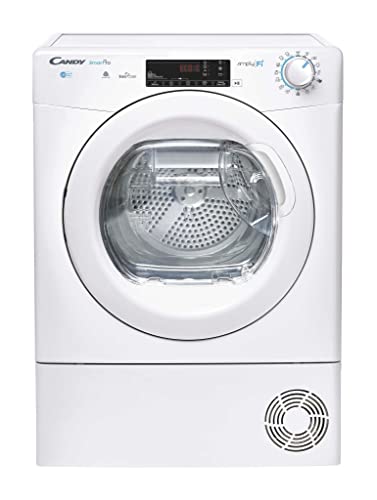Heat Pump Tumble Dryers
Heat pump tumble dryers recycle the hot air they use to dry your clothes, instead of venting it to the outside. This is a low-cost option for your household, as it conserves energy.
John Lewis has a range of tumble dryers that include both vented and condenser models as well as heat pump tumble dryers. Find out more in our guide to tumble dryers.
Cost
Tumble dryers can be ideal for reducing space and making it less necessary to dry laundry in the sunlight however, they do consume a lot of energy. If you're looking to reduce your energy costs, it may be worth trying an energy-efficient tumble dryer. While these machines do have a higher upfront cost, they will save you money over the long term because of their lower energy consumption.
The heat pump tumble dryers operate on the principle of heating air that has already warmed up during the drying process. This results in significantly lower energy costs than vented or condensation models. This type of tumble-dryer uses only half the energy as condenser or vented models, allowing you to save up to PS173 on your energy bills every year.
When comparing heat pump tumble dryers to other types, there is typically a minimal cost difference. It is essential to think about the amount of energy used and the frequency you use your tumble dryer. It is important to consider the wattage and your electricity bill when calculating how much each tumble dryer will cost you.
Vented tumble dryers use gas to dry the laundry and are powered by gas from the mains which means they are more expensive if you're on a tight budget. They also have a smaller range in their installation locations because they need to be placed in a room with appropriate ventilation to expel the humid air.
Condenser dryers take moisture out of the laundry by moving hot air into an individual condensing unit where it's converted to water. The water is then drained away either into a removable container that needs to be manually empty or be plugged into your drainage system for continuous removal. This will allow for greater flexibility when it comes to installation places, but you'll have to be prepared for additional maintenance by making sure the drain pipe is in good condition.
Energy efficiency
A tumble dryer heat-pump can help you save money on your energy costs. The technology uses less energy to heat the air inside the tumble dryer. This allows it to dry clothes more efficiently and at lower temperatures than vented models.

They also use a coolant that disperses the air's humidity and ejects it through the condenser. This means they require less electricity to operate than traditional vented dryers. They may take longer to finish your cycle of laundry than vented dryers but your clothes will be looking and feeling better for longer due to the lower temperatures for drying.
They cost an extra $500 to $700 up front but the energy savings could easily compensate for this. They're also more expensive and require adequate ventilation.
Like all electrical appliances, it's vital that any installation of a tumbler is completed by an experienced Gas Safe engineer. Ventilated dryers require a flexible, long vent hose permanently connected to the appliance at one end and a drainage hole at the other - either a drain, window or door. The hose needs to be secured in place and shouldn't be shared with any other appliance or used in any manner that could cause it to deteriorate.
Condenser dryers function in a similar way similar to heat pump dryers. They use an electrical element to warm the air and then expel the moisture through the condensation tray. They tend to be heavy-duty performers with larger capacity for wet loads ranging from 6kg to 10kg, and are quieter to operate. They're more expensive to purchase than heat pump tumble driers and cannot be set up without an permanent wall connection. The cost of running them is higher than heat pump dryers , because they require more heat to dry out the moisture in your laundry. They're also less efficient than vented models. They still require electricity to turn the motor which rotates your clothes.
Noise
Tumble dryers produce plenty of noise however how loud they are is contingent on a variety of variables. The decibel rating is only one of them, but the frequency of the noise can determine how loud it is. The sound may also be amplified by nearby resonant objects such as cabinets, work surfaces or furniture, and may be affected by the acoustics of the room. The sound of the tumble dryer may be dampened by acoustic absorbent fabrics such as carpets, or it can be drowned out by other appliances operating within your home.
Condenser and heat pump tumble dryers are quieter than vented models, but it's important to keep in mind that they're still loud. They're more gentle on fabrics, drying your laundry more slowly with lower temperatures of air and a much longer cycle than traditional models. This means they're less damaging to your clothes and are less likely to cause loss of colour that's often caused by high temperatures, old fashioned tumble dryers.
If you're planning to utilize your tumble dryer together with washing machines, it's important to remember that both appliances need to be placed close to each other in order to avoid vibrations and noise during operation. To prevent this issue it is recommended to use a washer and dryer stacking set is available for both types of appliances.
A heat pump tumble dryer needs to have an uninterrupted flow of air in order to function, therefore it's best to put it in a well-ventilated area in your home. You'll need to ensure that the vent hose is connected to the appliance and safely positioned out of your home instead of being redirected through a door or window.
The condenser dryer doesn't require a permanent connection to vents, and can be placed wherever in your house. It collects the leftover vapour and water in a condensation container that can either be manually emptied or connected to a drain with a drainage tube which will automatically empty it.
Converting a vented tumble-dryer to condenser dryer can be done by using the conversion kit. However, this could invalidate the warranty of the manufacturer and should only be done by a certified professional. The kits come with the components required to install the vent and a tiny water pump to remove the condensation, so they're not cheap.
Maintenance
The heat pump tumble dryers operate differently than condenser or vented dryers in that they don't need external venting in order to extract hot air. The warm air that passes over your clothes is collected and then run through a condenser that is able to separate the heated water from the air. It is then disposed in a reservoir of water (sometimes called a tank) inside the appliance. This means you'll have to empty the water tank at some time however it also allows you to keep the dryer in less space than if you needed to install a vent for the dryer.
The heat pump model is about 50% more energy efficient than vented models. According to Which? it is also more economical to run. It can save you between PS42 and PS51 per year. It's not cheap to buy a tumble dryer, therefore you'll need to be able pay for the initial costs.
A tumbler with a heat pump requires very little maintenance aside from cleaning the lint filters and looking for any fluff on the heater unit from time to time. You'll need to clean your condensation drain more often and it takes longer to dry clothes than a vented dryer.
If you are looking for a low-cost tumble dryer it is worth taking a look at an automatic model that ends when laundry is finished to avoid drying too long, which can cause damage to your clothes. You'll need to program your dryer's drying cycle if you have a lot of different types of fabrics.
Brands like Beko and John Lewis provide tumble dryers that utilize heat pump, condenser, or vented technology. John Lewis offers a free home delivery and a 2-year guarantee. Always check the warranty details carefully before purchasing an appliance, especially one that is electrical like a tumbler to ensure that you're covered in case of breakdowns or faults.
